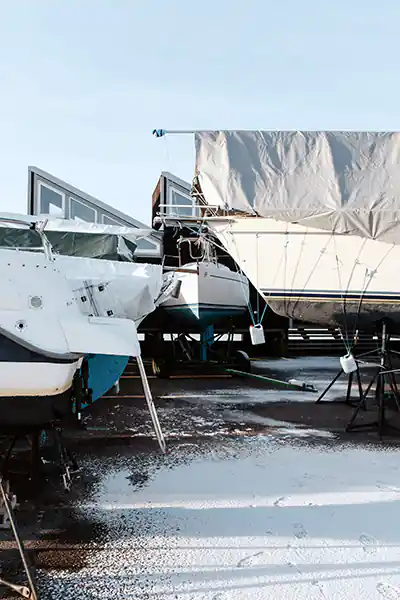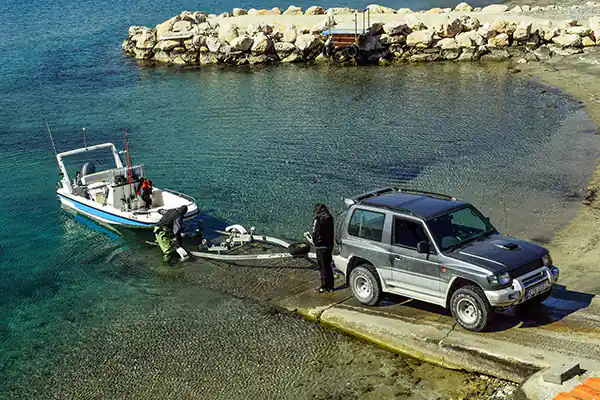Preparing your boat for winter: how to prevent problems?
As the autumn holidays roll in, daylight saving time ends, and the first gales blow, it’s the unmistakable sign that winter is approaching. To get your boat through the cold season, different solutions are chosen depending on the region, the size of the boat and the place where it is moored or parked: wintering afloat, hauling her out on the dry, or even storing here in the garden…
Whatever the chosen solution, the majority of boats on our coasts will go into hibernation mode. So, unless you’re a year-round racer, or an avid winter angler, now’s the time to make sure your boat doesn’t suffer any unnecessary wear and tear over the winter.
Instead of providing an endless list of tasks, we recommend using the Ready4Sea app. It tailors its checklist to your boat’s specific equipment and needs. In this article, we’ll focus instead on the key areas you should address.

Winterizing the engine
Whether you have an inboard or outboard engine (or both if your tender is motorized!), it is most vulnerable to a harsh winter. So let’s get off to a start off with everything mechanical.
The approach depends on your overwintering environment: whether afloat or on the dry, exposed to freezing temperatures or not, in a dry or wet climate, and how long you plan to be away. Ideally, make sure you run the engine regularly. Your engine will thank you for it. If you can’t visit, perhaps someone you trust, or a hired professional, can come aboard during the off-season.
If this isn’t an option, or the risk of freezing is significant, take steps to winterize the cooling system. Flush it with fresh water to remove salt, and the fill the circuit with antifreeze.
Grease and lubricate as many mechanical parts as possible, change the engine oil and and protect the engine block with an anti-corrosion spray.

Stripping the boat
Be sure to remove anything that might suffer from exposure to the elements. Sails, in particular, are not meant to be left in place unless you plan to sail during the winter.
Take down your lines and while you’re at it, you might want to take the opportunity to clean them (a cycle in the washing machine will work wonders). If possible, replace halyards with older ones or messengers lines instead.
Remove and store any textile or removable equipment to reduce windage, prevent items from lying off, or simply avoid damage. On the contrary, classic boats often require covers to prevent them from filling with rain. Similarly, if you have specific covers for certain equipment (especially portholes and hatches, which will then be better protected from UV rays), fit them. Make sure all these are securely fastened!

Emptying the boat
Equipment stored inside your boat isn’t necessarily protected from moisture. You’ll want to ensure the best possible air flow thanks to vents (point cowls in the right direction!) However, some items are best stored at home, in a dry place, whenever possible.
Sails, for instance, will avoid mildew and staining, as will foul-weather gear. When stored elsewhere, electronics will suffer less (and be less prone to theft), and your paper documents and charts won’t soften and stick. Food, bedding, and clothing have no business remaining on board during the winter. Best to take them ashore.
Give special attention to your batteries. Unless you have a large battery bank, it’s best to remove them and store them in a frost-free area where they can be recharged regularly. If they are too numerous and/or heavy, ensure they will last through the winter, perhaps thanks to a small solar panel.
Lastly, all tanks and systems should be drained, whether freshwater, greywater, or blackwater. An exception to this rule is your diesel tank; if some air remains in the tank, moisture may condense. In this case, water could collect beneath the diesel, and more humidity will then enter through the vent, continuing the process. So, leave your tank full, and add a biocidal stabilizer.

Cleaning the boat
Both the inside and outside of your boat require a thorough cleaning. On the deck hardware, the goal is to remove as much salt as possible to prevent corrosion to your hardware and fittings. Rainwater certainly won’t rinse every nook and cranny. Don’t forget to rinse your anchoring gear as well.
If you plan to remove your sails, now is the time to put put them through a good cleaning. As for the hull and deck, if this is the boat’s only haul out, it’s time for a scrub and new coat of paint or varnish! But that’s almost another subject in its own right.
Inside your boat’s cabin, focus on eliminating dirt and bacteria to prevent mold buildup over the winter. Cleaning with vinegar is often effective on all surfaces, including floorboards. If your boat has a head or shower, make sure they’re thoroughly cleaned to avoid unpleasant odors. Similarly, clean the bilges, which will also be a source of stench.
Lastly, any items remaining on board will need to withstand the winter. Protect metal parts and hardware from corrosion by spraying or applying some lubricant.
Ventilating the boat
Even if you’ve emptied parts of your boat, you’re likely to leave some things on board. Avoid the pitfall of leaving your boat too tidy! It’s better to leave your equipment in the middle of the saloon or cabins, with all lockers open and emptied, rather than sealing everything in poorly ventilated cupboards. Stow cushions on edge rather than leaving them flat.
However, don’t leave hatches or portlights open; rainwater could seep inside. Ensure they’re properly sealed and watertight. You can also consider using a dehumidifier or moisture absorber within the boat.
Mooring or securing the boat
Before leaving your boat, ensure it will securely stay in place. When afloat, this means doubling and checking the mooring lines, whether at a mooring, or alongside a dock or catway. Your boat should be prepared to withstand strong, repeated gales. Protect your lines if they might chafe.
For dry storage, whether on a trailer, chocks, or stands, check the stability of the arrangement. If it’s on a trailer, check its strapping or lashing. In most cases, the marina or yard operator will also inspect everything in case strong winds are forecast. But an extra check is never a bad idea, especially since it usually falls under your responsibility.

Your boat’s unique needs
While this article provides a comprehensive overview, remember that every boat is unique. When you call in a professional to winterize your boat, the upside is that he has the expertise to make sure you don’t forget anything: it’s his job!
But if you do the maintenance yourself, Ready4Sea offers adaptable checklists customized to your specific vessel’s equipment and needs. And to top it all off, it seamlessly records all your winterization efforts in your maintenance history.
Subscribe to our monthly newsletter to receive tips on keeping your boat in good health.
